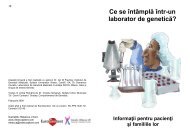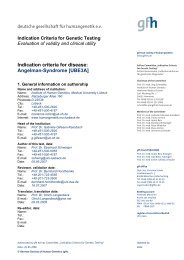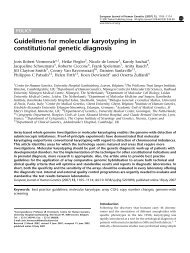Cytogenetic Guidelines and Quality Assurance - EuroGentest
Cytogenetic Guidelines and Quality Assurance - EuroGentest
Cytogenetic Guidelines and Quality Assurance - EuroGentest
You also want an ePaper? Increase the reach of your titles
YUMPU automatically turns print PDFs into web optimized ePapers that Google loves.
level of resolution for studies to establish common<br />
aneuploidies in constitutional cytogenetics. A 550<br />
bphs (QAS 6) level should be the minimum st<strong>and</strong>ard<br />
for referrals of mental retardation, birth defects, dysmorphic<br />
children or couples with recurrent pregnancy<br />
loss.<br />
Where it is not possible to achieve the minimum<br />
quality for the referral reason, <strong>and</strong> no clinically<br />
significant abnormality is detected, the report should<br />
be suitably qualified whilst not encouraging repeat<br />
invasive procedures when these are NOT clinically<br />
justified.<br />
4.4 ANALYSIS<br />
4.4.1 KARYOTYPING/<br />
CHROMOSOME ANALYSIS<br />
In general, a minimum of 5 cells should be fully analysed<br />
for constitutional analysis <strong>and</strong> 10 cells for a haematological<br />
analysis. If metaphase analysis involves a<br />
comparison of every set of homologues (including X<br />
& Y), b<strong>and</strong> by b<strong>and</strong>, then a minimum of 3 metaphases<br />
can be fully analysed. If one of the homologue pair is<br />
involved in an overlap with another chromosome the<br />
pair of homologues should be independently scored to<br />
ensure there is no structural rearrangement.<br />
Additional cells may be counted depending on laboratory<br />
policy. An extended analysis <strong>and</strong>/or cell count is<br />
warranted when mosaicism is clinically indicated or<br />
suspected. The laboratory should have written protocol<br />
for the analysis criteria.<br />
Hyper- <strong>and</strong> hypodiploid <strong>and</strong> polyploid cells should be<br />
fully analysed in constitutional <strong>and</strong> haematological<br />
analysis.<br />
All cases should have an image or a slide stored for<br />
later review (see section 11.12.1).<br />
Refer to the current ISCN for the definition of a clonal<br />
abnormality.<br />
4.4.2 CHECKING<br />
Checking of all cases by a second qualified cytogeneticist<br />
is essential. A senior supervisor or an<br />
experienced cytogeneticist should check the analysis.<br />
4.5 INTRODUCTION OF NEW LABORATORY<br />
PROCEDURES<br />
A laboratory should, when starting any new diagnostic<br />
service, have a protocol for training staff <strong>and</strong> testing<br />
new equipment so patients are not at risk from inappropriate<br />
h<strong>and</strong>ling of equipment/slides etc. One way<br />
of doing this is to divide the samples, <strong>and</strong> send half to<br />
an experienced laboratory until the necessary level of<br />
competence is achieved. Validation <strong>and</strong> SOPs of these<br />
procedures is required.<br />
4.5.1 USE OF MOLECULAR TECHNIQUES<br />
When molecular genetic techniques are more sensitive<br />
than conventional cytogenetics, they should be used<br />
once the method has been validated, (e.g. for Angelman<br />
or Prader Willi syndrome, other microdeletion<br />
syndromes, Fragile X syndrome, etc). This could<br />
result in onward referral of cases if a laboratory is<br />
unable to undertake such analysis. Exclusion of other<br />
19<br />
chromosome abnormalities may still be required in<br />
most cases.<br />
5. SPECIFIC CHROMOSOMAL ANALYSIS<br />
5.1 PRENATAL<br />
5.1.1 AMINOCYTE CULTURES<br />
To minimise the risk of contamination, or culture loss<br />
due to incubator failure, duplicate cultures should<br />
preferably be h<strong>and</strong>led separately, kept in separate<br />
incubators, if possible, running on a different electrical<br />
circuits. Prenatal cultures should be maintained with<br />
two different cell culture media, or with different<br />
batches of the same cell culture media <strong>and</strong> other reagents.<br />
The possibility of maternal cell contamination,<br />
pseudomosaicism, true mosaicism <strong>and</strong> in vitro<br />
aberrations must be recognised <strong>and</strong> the system of<br />
culture <strong>and</strong> analysis used designed to detect <strong>and</strong><br />
differentiate these problems.<br />
Harvesting or subculturing of all cell cultures from an<br />
individual sample together should be avoided.<br />
If possible back up cultures should be kept until the<br />
final report is written.<br />
Facilities should be available for freezing viable cells,<br />
e.g. for unresolved cases of abnormal foetal pathology.<br />
5.1.2 CHORIONIC VILLI CULTURES<br />
Before a CVS sample is cultured it must be dissected<br />
<strong>and</strong> maternal decidua separated from the villus to<br />
reduce the chance of maternal cell contamination. It<br />
should be clear from the referral form whether the<br />
sample has been dissected or not prior to its’ arrival in<br />
the laboratory. If an initial cytogenetic diagnosis is<br />
made on short-term preparations, a long term culture<br />
should be available for confirmation, in order to<br />
minimise problems of interpretation (Eucromic 1997,<br />
ACC Collaborative study, 1994). Analysis solely on<br />
short-term incubation preparations (direct preparations)<br />
is not recommended (Eucromic 1997, ACC<br />
Collaborative study, 1994). If the sample is of an<br />
inadequate size for both short <strong>and</strong> long term cultures,<br />
analysis from a long term culture is recommended.<br />
5.1.3 FOETAL BLOOD CULTURES<br />
The foetal blood sample should be checked to ensure<br />
it is not mixed with maternal blood, <strong>and</strong> originates<br />
only from the foetus. Several haematological methods<br />
are available. (Alkaline Phosphatase, Kleinhauer,<br />
Coulter counter sizing). Both foetal blood <strong>and</strong><br />
amniotic fluid samples should be analysed unless there<br />
is a valid reason not to do so e.g. abnormal foetal<br />
blood result <strong>and</strong> pregnancy terminated.<br />
5.1.4 MOSAICISM IN PRENATAL STUDIES<br />
Two or three cultures should be set up for each<br />
sample. Analysis of a second or third culture is<br />
essential in cases of suspected mosaicism or pseudomosaicism<br />
e.g. trisomy 2 or where the abnormality is<br />
not consistent with continued fetal development (see<br />
Hsu et al., 1996, 1997). In general, if the same abnormality<br />
is present in two independent cultures,<br />
mosaicism is confirmed.<br />
For in situ preparations, analysing cells from one cell<br />
culture may be sufficient if not all from the same















